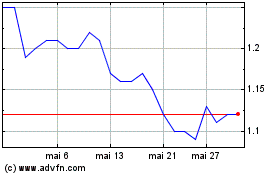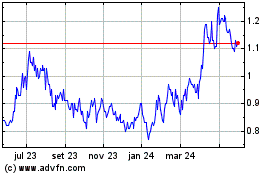Alphamin Resources Corp.: Exceptional Drill Results from Alphamin's Bisie Tin Project, Democratic Republic of the Congo
15 Julho 2013 - 3:18PM
Marketwired Canada
Alphamin Resources Corp. (TSX VENTURE:AFM) ("Alphamin" or the "Company") is
pleased to announce results for the first seven holes completed in the current
resource drilling programme at Gecomines and one hole drilled at Golgotha in
2012 on its wholly owned Bisie Tin Prospect (Bisie Project) in east central
Democratic Republic of the Congo (DRC). Three thousand two hundred and twenty
seven metres have been completed to date. The programme was extended to
incorporate 4 additional holes to confirm continuation of significant tin
mineralisation intersected at depth. Results from all drill holes and a maiden
resource estimate are expected before the end of the third quarter, 2013.
All drill holes completed to date are shown in the drill hole locality map under
Figure 1 and results are summarized in Table 1. A best intersection of 24m @
3.99% Sn from 100m including 6.4m @ 7.99% Sn from 109.1m was reported from
BGC018, also shown in the section in Figure 2. BGC018 is interpreted to lie
within a high grade mineralised chute which plunges at a shallow angle to the
north where best visible tin mineralisation (cassiterite) was intercepted in the
northernmost hole (BGC034) at depth. A photograph of hydrothermal "wood" tin
intercepted in BGC034 is shown in Figure 3. Other drill holes falling within the
high grade chute included BGC001 (12m @ 3.15% Sn and 3m @ 6.14% Sn), BGC007
(18.5m @ 2.21% Sn) and BGC002 (25.85m @ 2.26% Sn). Strong brecciation of the
cassiterite veins, faulting or stoping out by barren quartz veins would account
for lower grade or narrow intercepts within the high grade zone.
Drill holes BGC011A, BGC012, BGC013, BGC014 and BGC015 were planned to intercept
mineralisation at shallow levels. BGC013 and BGC015 were drilled through
artisanal workings (mined out cassiterite veins) while BGC014 drilled between
BGC013 and BGC015 reported a significant result of 20m @ 1.26% from 21.5m
including 3.5m @ 4.97% Sn from 21.5m confirming near surface high grade
mineralisation. A low grade zone of mineralisation was intersected adjacent to
the artisanal workings and included 20.5m @ 0.4% Sn from 17m including 2.5m @
2.07% Sn from 34m (BGC013) and 21.9m @ 0.37% Sn from 17.1m (BGC015) confirming
significant widths of low grade tin surround the high grade mined out veins.
BGC012 was drilled above the mineralised zone which plunges to the north and
reported a narrow zone of 1.4m @ 0.67% Sn from 18m.
Copper grades tend to increase northwards where a best intersection of 26.5m @
0.29% Cu from 52.5m including 3m @ 1.08% Cu from 71.5m (BGC012) was reported
from a separate zone in the footwall of the tin zone.
Tin mineralisation at Gecomines has been confirmed over 325m from drilling and
is focused within a chloritic, garnetiferous amphibolite unit within felsic mica
schists. Occasionally cassiterite bands are developed in the footwall schists in
close proximity to the amphibolites. The amphibolite unit is consistently 20-25m
thick although in some drill holes the unit and corresponding tin mineralisation
might be less due to faulting or quartz veining. This mineralisation is open at
depth to the north and at depths below 225m.
The single result of 36m @ 0.56% Sn from 164m including 14.8m @ 1.13% Sn from
171.2m in BGH007A reported from Golgotha confirms the tin potential of the
Golgotha target area. Drilling has confirmed an excellent correlation exists
between tin mineralisation and lead (Pb) and arsenic (As) path finder elements
from soil sampling at surface. The Golgotha target area is associated with a
3,000m Pb andAs in soil anomaly confirming the potential of the Golgotha target.
A second zone of silver, lead and zinc mineralisation is better developed
southwards of the Gecomines target and generally occurs within the hangingwall
of the tin mineralised zone. Significant results in BGH007A included 7.03m @
37.4g/t Ag from 117.9m, 7.03m @ 1.41% Pb from 117.9m and 3.65m @ 6.07% Zn from
132.4m.
Additional drilling results at Bisie continue to firm up the robust geological
model which is guiding the current resource drilling programme and future
exploration. Once the current resource drilling programme has been completed the
Company plans to fly an aeromagnetic survey over the ridge to better define
drilling targets to the south of Gecomines in the Golgotha target area. The
mineralised ultramafic unit is more magnetic than the surrounding mica schists
and is expected to better define regional drilling targets when combined with
the As and Pb in soil geochemistry.
The MSA Group in Johannesburg, South Africa, have been contracted to conduct a
maiden NI43-101 Resource Estimate, a Technical Report and a Preliminary Economic
Assessment scheduled for completion during the third quarter 2013.
Project Background
The Bisie project is located in the Walikale district of North Kivu Province DRC
and is held by Alphamin's 100% owned Mining and Processing Congo sprl (MPC)
which holds a total of five tenements covering an area of 1,470sqkm with
significant tin, gold and base metal potential. The key prospects within the
Bisie Project are the Bisie Tin Prospect mined previously by artisanal means and
the Omate gold workings exploited historically by the Belgians and currently
mined extensively by artisanals.
The Bisie Prospect was the DRC's largest producer of tin ore for a number of
years and accounted for up to 75% of the DRC's tin output.
Alphamin lifted force majeure on PR5266 which hosts the Bisie Prospect in
February 2012 and commenced diamond drilling during the second half of 2012 at
two target areas, Gecomines and Golghota, mined extensively from surface by
artisanal miners. Significant high grade tin mineralisation was reported from
drilling at both target areas down to depths exceeding 200m. The tin
mineralisation is also closely associated with copper and light rare earth
(cerium and lanthanum) mineralisation as well as massive and disseminated lead
and zinc sulphides and significant amounts of silver. Geochemical soil sampling
has highlighted anomalous lead in soils for a further 3km to the south of the
Golghota workings. Drilling has confirmed the association of copper, lead, zinc
and tin mineralisation at depth below the soil anomaly in holes drilled to the
south of the Golghota workings.
The lead in soil anomaly has been defined over a minimum of 4km along the Bisie
ridge and remains open to the south where the soil sampling has not been
completed. High grade mineralisation at Bisie appears to be controlled by a
series of crosscutting northeast or east-west trending faults identified along
the ridge from Landsat imagery. The Company is therefore highly confident of
discovering new high grade zones of tin and base metal mineralisation from
systematic exploration along the ridge.
Lars Pearl, a qualified person under National Instrument 43-101, has verified
technical data disclosed in this release.
ON BEHALF OF THE BOARD OF DIRECTORS
Cosme Maria Beccar Varela, President and CEO
Neither the TSX Venture Exchange nor its regulation services provider (as that
term is defined in the policies of the TSX Venture Exchange) accepts
responsibility for the adequacy or accuracy of this News Release.
CAUTION REGARDING FORWARD LOOKING STATEMENTS
Information in this news release that is not a statement of historical fact
constitutes forward-looking information. Such forward-looking information
includes statements regarding the Company's planned exploration programs. Actual
results, performance or achievements of the Company may vary from the results
suggested by such forward-looking statements due to known and unknown risks,
uncertainties and other factors. Such factors include, among others, that the
business of exploration for tin and other precious and base minerals involves a
high degree of risk and is highly speculative in nature; few properties that are
explored are ultimately developed into producing mines; geological factors; the
actual results of current and future exploration; changes in project parameters
as plans continue to be evaluated, as well as those factors disclosed in the
Company's publicly filed documents.
There can be no assurance that any mineralisation that is discovered will be
proven to be economic, or that future required regulatory licensing or approvals
will be obtained. However, the Company believes that the assumptions and
expectations reflected in the forward-looking information are reasonable.
Assumptions have been made regarding, among other things, the Company's ability
to carry on its exploration activities, the sufficiency of funding, the timely
receipt of required approvals, the price of tin and other precious and base
metals, that the Company will not be affected by adverse political events, the
ability of the Company to operate in a safe, efficient and effective manner and
the ability of the Company to obtain further financing as and when required and
on reasonable terms. Readers should not place undue reliance on forward-looking
information.
Alphamin does not undertake to update any forward-looking information, except as
required by applicable laws.
NOTES -DRILLING
Drilling results are quoted as downhole intersections. True mineralisation width
is approximately 80% of intersection length for all holes. The reported grades
were determined using a cut-off grade of 0.1% Sn, 25g/t Ag, 1% Zn, 1% Pb and
0.1% Cu to select significant and anomalous intersections, with a maximum of 3m
internal dilution being incorporated into the composite where appropriate. A top
cut of 60% was applied to Sn, 30% to Zn and 20% to Pb.
Half core samples for all drillholes were submitted to accredited ALS Chemex
laboratory in Johannesburg where samples were analyzed using ME-XRF05 conducted
on a pressed pellet with 10% precision and an upper limit of 10 000ppm. Over
limit samples were sent to Vancouver for ME-XRF10 which uses a Lithium Borate
50:50 flux with an upper detection limit of 60% and precision of 5%. ME-ICP61,
HF, HNO3, HCL04 and HCL leach with ICP-AES finish was used for 33 elements
including base metals. ME-OG62 a four acid digestion was used on ore grade
samples for Pb, Zn, Cu & Ag. Industry accepted QA/QC checks were applied
including use of duplicates, blanks and standards.
Tables and maps are available at the following address:
http://media3.marketwire.com/docs/n715afm1.pdf.
FOR FURTHER INFORMATION PLEASE CONTACT:
Alphamin Resources Corp.
Level 3, Gotthardstrasse 20, CH-6304
Zug, Switzerland
+41 41 711 02 81
www.alphaminresources.com
Alphamin Resources (TSXV:AFM)
Gráfico Histórico do Ativo
De Mai 2024 até Jun 2024

Alphamin Resources (TSXV:AFM)
Gráfico Histórico do Ativo
De Jun 2023 até Jun 2024
